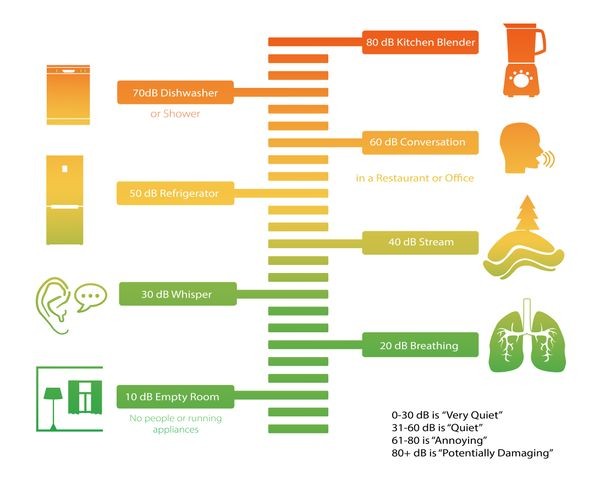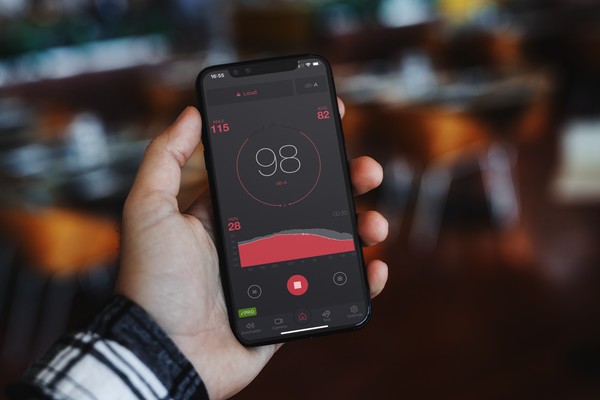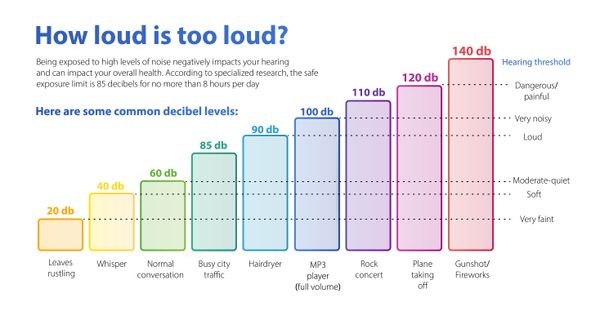Are you curious about sound levels and wondering what 70 dB is comparable to? This article from COMPARE.EDU.VN breaks down the meaning of 70 decibels, providing relatable examples and insights to help you understand sound intensity and its impact on your hearing. We’ll explore everyday sounds that match this level and guide you on protecting your hearing health.
1. Defining 70 Decibels: A Moderate Sound Level
Decibels (dB) are the unit of measurement for sound intensity, ranging from the threshold of human hearing at 0 dB to the threshold of pain around 120-140 dB. 70 dB sits in the middle, representing a moderate sound level akin to a typical washing machine. It’s also comparable to the noise inside a car traveling at 60 mph or the general sound level in an open-plan office.
2. How Loud is 70 dB? Everyday Examples
70 dB is about as loud as a washing machine or dishwasher running. While not immediately harmful, prolonged exposure to sounds above 55-60 dB can become bothersome.
The Environmental Protection Agency (EPA) considers 70 dB over 24 hours as the maximum safe level to prevent hearing loss over a lifetime. This doesn’t mean it’s completely harmless, but rather the limit for average daily exposure. If you encounter louder noises, compensate with periods of quiet to protect your hearing. Many workplaces limit noise exposure to 85 dB over an 8-hour workday.
3. What Does 70 dB Sound Like In Real Life?
Imagine standing near a running washing machine or working in a busy office. That’s what 70 dB sounds like.
Your distance from the sound source influences how loud it seems. The closer you are, the louder the noise. While a brief exposure to 70 dB might not be irritating, prolonged or repeated exposure can be distracting, raise blood pressure, and cause other health issues.
4. Common 70 dB Sound Sources
Here are some common examples of 70 dB sounds:
- Normal Conversation: 60-70 dB
- Open Office Noise: 65-75 dB
- Alarm Clock: 70-80 dB
- Washing Machine: 70 dB
- Dishwasher: 70 dB
- Restaurant: 70-80 dB
- Vacuum Cleaner: 60-80 dB
5. Why Monitoring Noise Levels Matters
Measuring noise levels is crucial for preventing hearing damage. Noise-induced hearing loss is irreversible, making prevention paramount.
Regularly monitor noise levels at home and work. This is especially important at loud events like concerts or sports games.
6. Is 70 dB Considered Too Loud Long Term?
70 dB is a moderate sound level and not considered immediately dangerous. However, it represents the upper limit of the EPA’s recommended 24-hour average noise exposure. Sustained exposure above this level can lead to hearing issues. If you are exposed to louder sounds, balance it with periods of quiet.
7. What Decibel Levels Pose a Danger to Hearing?
Sound levels exceeding 85 dB are considered dangerous and can damage your hearing, especially with prolonged exposure.
Workplace regulations generally require employers to provide hearing protection when noise levels average above 80-85 dB over an 8-hour workday. Public environments lack defined dangerous noise limits, but the recommended maximum is 70 dB over 24 hours.
8. The Consequences of High Decibel Exposure
Loud noise can damage the nerve endings in your inner ear, leading to temporary or permanent hearing damage and ultimately, irreversible hearing loss. Prevention through noise monitoring is crucial.
9. Protecting Your Hearing: Practical Strategies
You can protect your hearing by:
- Avoiding Unnecessary Exposure: Minimize time in loud environments.
- Adjusting Volume: Lower the volume on personal devices.
- Using Hearing Protection: Wear earplugs or earmuffs in noisy settings.
Remember, 70 dB is the recommended maximum exposure over 24 hours. If you struggle to hear someone speaking over the noise, it’s too loud.
10. Practical Methods to Protect Your Hearing
| Method | Description |
|---|---|
| Adjust the Volume | Reduce the volume on music or TV to prevent hearing damage. Balance loud music with quiet periods. |
| Distance from Sound Source | Move away from loud sounds. Increased distance reduces the risk of hearing damage. |
| Use Hearing Protection | When you can’t control the volume or distance, use earmuffs or earplugs. They are available online and in specialty stores. |




11. Using Sound Level Apps for Noise Measurement
Use a sound level app to measure noise levels easily.
12. COMPARE.EDU.VN: Your Partner in Informed Decision-Making
Navigating the complexities of sound levels and making informed choices to protect your hearing can be challenging. At COMPARE.EDU.VN, we understand the importance of clear, reliable information. We’re dedicated to providing comprehensive comparisons across a wide range of products, services, and ideas, empowering you to make confident decisions.
Our website offers detailed analyses, side-by-side comparisons, and expert insights, all designed to simplify the decision-making process. Whether you’re comparing the noise levels of different appliances or evaluating the best hearing protection options, COMPARE.EDU.VN is your trusted resource.
Here’s how COMPARE.EDU.VN can help you:
- Detailed Comparisons: Access in-depth comparisons of products and services, including noise levels, features, and user reviews.
- Unbiased Information: Benefit from our commitment to providing objective and unbiased information, ensuring you have all the facts.
- Expert Insights: Leverage expert opinions and analysis to gain a deeper understanding of the factors that matter most to you.
- User-Friendly Interface: Enjoy a seamless browsing experience with our intuitive website design, making it easy to find the comparisons you need.
At COMPARE.EDU.VN, we believe that informed decisions lead to better outcomes. Let us help you navigate your choices with confidence.
13. Understanding Sound and Making Informed Decisions: Further Insights
When it comes to understanding sound and its impact on our lives, knowledge is power. By gaining a deeper understanding of decibel levels and the potential risks associated with excessive noise exposure, you can take proactive steps to protect your hearing and overall well-being. COMPARE.EDU.VN is committed to providing you with the resources and information you need to make informed decisions about sound-related products and services.
Here are some additional areas where COMPARE.EDU.VN can help you navigate the world of sound:
- Home Appliances: Compare the noise levels of different washing machines, dishwashers, vacuum cleaners, and other appliances to create a quieter home environment.
- Audio Equipment: Evaluate the sound quality, noise cancellation capabilities, and safety features of headphones, speakers, and other audio devices.
- Hearing Protection: Compare the effectiveness, comfort, and suitability of various earplugs, earmuffs, and other hearing protection devices for different situations.
- Acoustic Solutions: Explore different acoustic panels, soundproofing materials, and other solutions for reducing noise in your home, office, or studio.
By providing comprehensive comparisons and expert insights, COMPARE.EDU.VN empowers you to make informed choices that align with your specific needs and preferences. Whether you’re seeking a quieter home, a better audio experience, or enhanced hearing protection, we’re here to help you navigate the complexities of sound and make the best decisions for your well-being.
14. Ready to Make Smarter Choices?
Don’t let the complexities of comparing options overwhelm you. Visit COMPARE.EDU.VN today and discover how easy it is to make informed decisions.
Ready to Dive Deeper? Here Are Some Frequently Asked Questions About Sound Levels:
1. What is considered a safe level of noise exposure?
The EPA recommends a maximum average exposure of 70 dB over 24 hours to prevent hearing loss.
2. How can I measure the noise levels in my environment?
Use a sound level meter app on your smartphone or a dedicated sound level meter device.
3. What are the long-term effects of exposure to loud noise?
Prolonged exposure to loud noise can lead to hearing loss, tinnitus (ringing in the ears), and other health problems.
4. Are some people more susceptible to noise-induced hearing loss?
Yes, factors like genetics, age, and pre-existing hearing conditions can influence susceptibility.
5. What are the first signs of noise-induced hearing loss?
Early signs may include difficulty hearing high-pitched sounds, muffled hearing, or tinnitus after exposure to loud noise.
6. How effective are earplugs in protecting my hearing?
Earplugs can significantly reduce noise exposure, but their effectiveness depends on proper fit and usage.
7. Can I reverse noise-induced hearing loss?
Unfortunately, noise-induced hearing loss is usually irreversible. Prevention is key.
8. Are there any treatments for tinnitus?
While there’s no cure for tinnitus, various treatments can help manage the symptoms, such as sound therapy and counseling.
9. How often should I get my hearing checked?
Regular hearing checkups are recommended, especially if you work in a noisy environment or have concerns about your hearing.
10. Where can I find more information about hearing protection and noise reduction?
Visit COMPARE.EDU.VN for comprehensive comparisons, expert insights, and resources on hearing protection and noise reduction solutions.
Making informed decisions is easier than ever with COMPARE.EDU.VN.
Contact us:
Address: 333 Comparison Plaza, Choice City, CA 90210, United States
Whatsapp: +1 (626) 555-9090
Website: compare.edu.vn